TABLE OF CONTENTS
The General Ledger
The General Ledger contains all of the accounts for recording the business transactions. They track the transactions relating to the company’s assets, liabilities, equity, revenue and expenses.
The listing of the account names is called a chart of accounts. Reports to show the financial position of the business are drawn from this area.
Bizprac comes with a standard set of ledgers which can be adjusted or added to suit the business requirements. Additional ledgers and sub accounts can also be added.
In Bizprac, it is the ledger or account class, not the digits that designate the class of an account. If you happen to get the class of an account incorrect, it is easy to change without upsetting the balances or transactions.
Ledger Account Details
Account name: Although these are arbitrary names, they should describe how the money was used. For example Stationary, electricity etc. The names can be adjusted to suit the business or new ledgers added.
Ledger class: This is the type of account; for example bank accounts are usually an Asset. Materials & purchases are either expenses or cost of goods sold.
Account number: Used to separate ledgers into groups. Can be used as a header account as well as sub accounts.
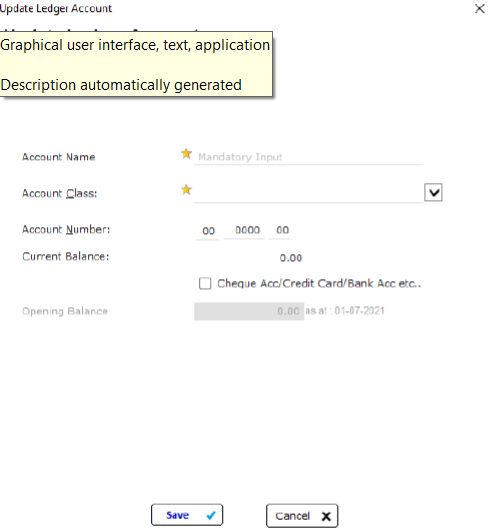
How Account Numbers Work
For this example we will use the number: 00-0176-00
00-0176-00:-This is a department number. It can have a value of 0 to 10 separate accounts books within the 1 Accounts Bookset. Each department’s accounts are kept separate from those of the other departments, allowing for profit & loss reporting on each department.
00-0176-00:-This is the actual account number for the ledger. It can have a value of 0001 to 9999. Accounts of the same class are usually numbered within a numbering range.
00-0176-00:- This denotes the ledger as the header account or title account. Sub accounts can be added under a header.
00-0176-01:- Denotes a sub account to the above header account. Sub accounts can be added consecutively as required.

Adding Bank Accounts
Add the name of the Bank account
From the drop down list select the class as a “current asset”
Add the account number you wish to use
Check the box stipulating the ledger as a bank account
An opening balance can be added; if you are starting a new bookset or are new to using Bizprac defer adding an opening balance straight away. Refer to the opening balance guide for further clarification.
Once the details have been added click the save button.

Direct Payments Setup
The fields in the Direct Payment tab need to be completed if you wish to create ABA files for making payments.
The information will need to be supplied by your banking institute.
Add the BSB and account details. It is not necessary to add spaces into the bank account field. Enter the numbers in with no spaces.
Tick create self balancing record. The second option should only be ticked if directed to do so by the bank.
For information about setting up Trust Accounts, please refer to the relevant guide.
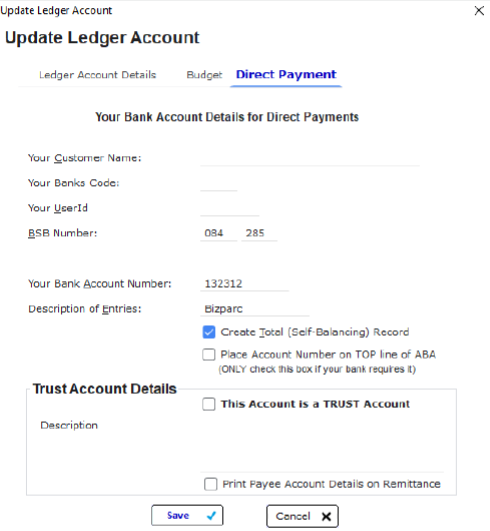
Adding New Ledgers
Add the name of the ledger
From the drop down box select the class of the account
Add the number of the account being added
Once complete click save to finalise the record
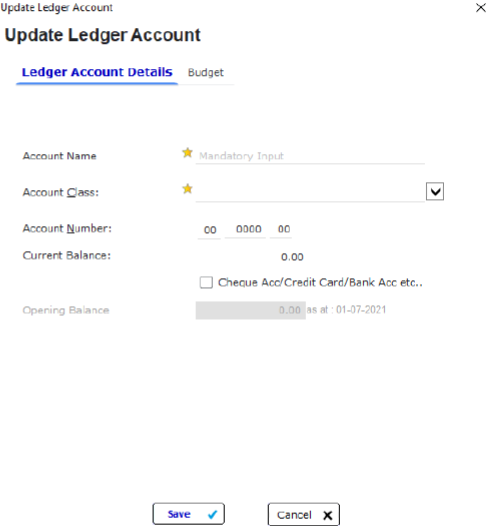
Adding A Sub Account
A sub account can be added under any ledger account number ending with -00.
Add the same account number as the header account but the last 2 digits will be 01,02 etc.
This will group the ledgers under the main account. You will be able to report separately or under the main ledger.
Sub accounts will always be of the same class as the header account.

Archiving Ledgers
Under the utilities menu there is a option to archive any unused ledgers. This option is preferable to deleting unused ledgers.
The program will not allow you to archive ledgers that are required for the running of reports or that have transactions attached to them.
Should you wish to use the ledger again; simply go the archived list and highlight the required ledger and unarchive. This will place the ledger back in the list for use.
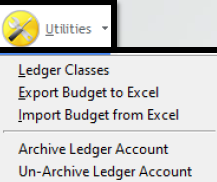

Changing the Class
Should you wish to change the class of a an account, click the modify button.
From the drop down list select the class you wish to change to.
Once selected click save to finalise the change. All transactions within the ledger will be adjusted accordingly.

Tips for the General Ledger
The General Ledger of Bizprac is the centre for all of the business accounts. Bizprac varies from generic accounting packages in a number of areas.
The job costing is completed through the jobs section of the program; so there is no need for an extensive list of ledgers to track costing. Ledgers can be added as required but are not needed for job reporting; so it is recommended that ledgers be kept to a minimum. Ledgers are not required to be linked to GST codes; which allows for flexibility if an adjustment needs to be made. It also ensures a greater degree of accuracy for preparing the BAS.
In comparison to other accounting packages the list of tax codes may seem quite small. Don’t be fooled into thinking you need a long list of tax codes to manage your business. Bizprac’s list of pre-set codes will help you accurately track and report for your business. Using Bizprac’s estimating and account integrated package allows you to report accurately and in real time without the use of extensive ledgers or GST codes.
Whilst all care is taken to ensure that the GST codes used are suitable for the construction industry; individual business needs may vary or change over time. We recommend that you periodically review the codes and ensure that the setup meets your needs. Additional codes can be added as required. If you have any questions regarding GST codes that you should be using please consult the ATO or your Accountant.
Some Do's and Don'ts
Bizprac has an inbuilt ledger integrity check; this report will provide you with a health check of your accounts data. It will alert you to any potential problems and provide direction for what needs to be rectified before it becomes an issue. Run this report regularly to keep a keen eye on your accounts.
General Journal entries are a useful tool to move amounts between accounts. It should be noted that General Journal entries CANNOT be posted to the Accounts Payable or Accounts Receivable ledgers. Should it be necessary to adjust either of these 2 ledgers, it must be completed within the ledger itself. We would recommend a cross check of reports to ensure any adjustments are made in the correct area. When running payroll the general journal entry will post automatically.
GST Codes
Bizprac comes standard with a list of GST codes relevant to the building and construction industry. The most common codes used are:
➢ GST: used for taxable supply and purchases and is currently 10%
➢ GSF: usually used or supply of basic items such as food, health care, rates etc. Some items such as stamp duty may also be allocated to this code.
➢ GNR: will generally apply to a sub contractor who has an ABN but is not registered for GST.
Transactions such as transfers between accounts, superannuation payments and wages where no GST is applicable can be left blank.
Some transactions may need to use 2 codes; Insurance Premiums are common for this type of transaction, as part of the cost is subject to GST and part such as the stamp duty may be GSF. Transactions such as these must be entered as 2 lines in the invoice or cash payment using the relevant codes.
Tax Code Comparison
Inbuilt tax codes simplify and reduce the time it takes to prepare the BAS. The accuracy of the BAS will depend on the accuracy of the transactions entered. Always use the BAS audit trail to check over the relevant transactions and ensure that the transactions are sitting where they should be. This will allow you to make any adjustments if necessary prior to the BAS being lodged.
The next slide shows a number of codes commonly used in generic accounting packages; we have included the equivalent code or action required in Bizprac. The list includes the commonly used codes and does not cover all possibilities.
Please note that Bizprac staff are not tax professionals, if you have additional questions regarding the setup or use of codes please consult the ATO or your accountant. Our support team will then be able to assist you with the correct setup of the program.
Comparison Chart

Bizprac is Different to Generic Accountant Software
In generic accounting software the first digit of the accounts determines the class of the account. In Bizprac it is the ledger or account class which designates the account as an asset, liability etc. Simply select the class name from the ledger classes list.
If you happen to select the wrong class in your setup; it is easy to change them without upsetting the balances.
General Ledger View
From this screen you can add, modify or delete ledgers. Click on each of the tabs for a view of what ledgers are in each class.
Use the blue arrow to drill down into each of the individual ledgers.
The BAS can be accessed directly from this screen.

Audit Trial
Using the blue arrows you can drill into each ledger.
From this screen you can scroll through each ledger using the next and previous buttons.
Using the select period option you can use a selected date range to view the transactions.

Archiving Accounts
Ledger accounts that are no longer required can be archived.
Simply highlight the ledger you wish to archive and make the selection from the drop down box in the utilities menu.
Should you change your mind and wish to activate the ledger again use the utilities to unarchive the ledger.
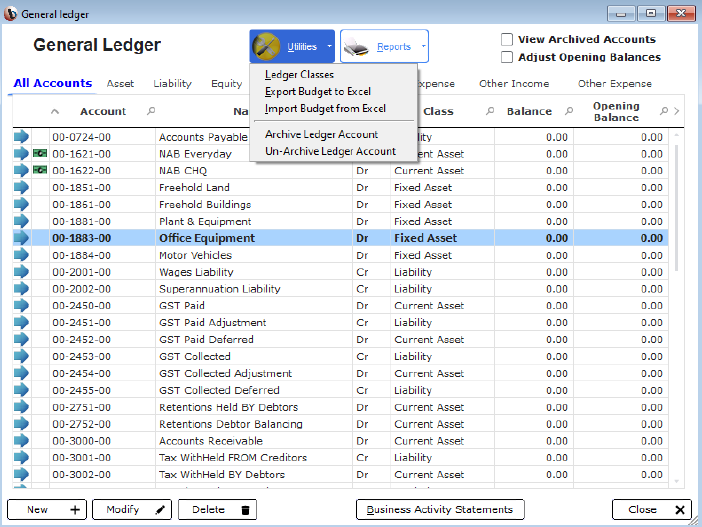
General Ledger Setting up Bank Accounts
Identifying Bank Accounts
Bank accounts in the listing of ledgers are identified easily by the green icon next to them.
Only bank accounts that need to be reconciled will be marked with this icon.
Bizprac by default has 2 ledgers designated as bank accounts; Cash at Bank and Cash on Hand. You can either modify these 2 accounts to reflect you bank accounts or add bank account ledgers.

Bank Account Ledgers
Add the details of the account; if you have several accounts with the same bank ensure you make each account easily identifiable.
Tick the box that identifies the ledger as a bank account. The opening balance can be added at this screen; if you are new to using Bizprac it may be advisable to defer adding a balance.
Repeat adding bank account ledgers for the number of accounts that the business uses.
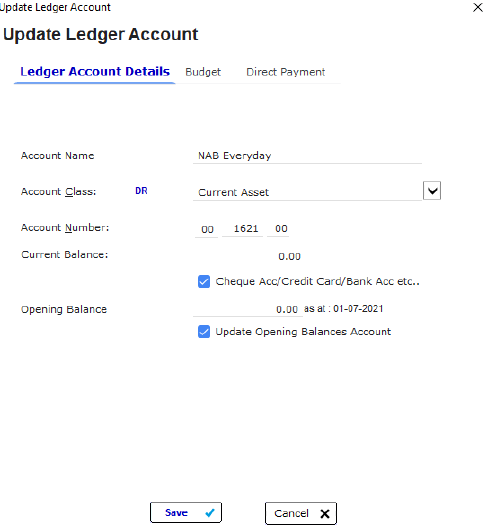
Setting Up Direct Payments
To create ABA files for direct bank payments; the direct payments tab will need to be setup.
Add the details as provided by your banking institution; all details will need to be added for the file to be created. Remember you will also need to add bank details for anyone you wish to pay in this method.
Tick create a self balancing record. Your bank will advise if the second tick box option is required.
For the setup of Trust Accounts please refer to the Trust Accounts Guide.

Set Default Accounts
Once the bank account ledgers have been added you can set the defaults for cash payments and also cash receipts.
Go to the setup tab ➔settings ➔program settings ➔Default ledger accounts.
Default ledgers can be set for the BAS if you have FBT obligations or qualify for a Diesel fuel rebate.
If you change bank accounts the defaults can be reset in this area.
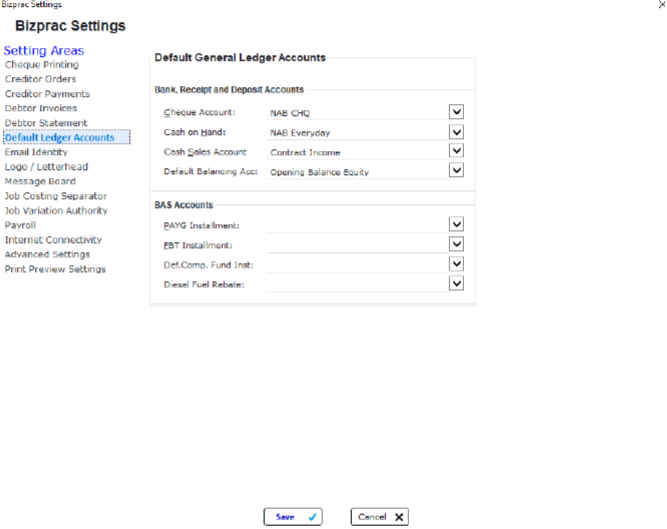
Credit Card Processing
Credit Card Ledger
Ensure you have a credit card ledger.
It must be setup as a liability and tick the box to designate the ledger as a bank account/ credit card.

Making Cash Payment
Begin a new cash payment, from the drop-down selection choose the credit card.
Ads you tab through to begin entering details of the payment, a warning will appear.
Click on “use this account” this will allow the transaction to be recorded against the credit card and record the expense.
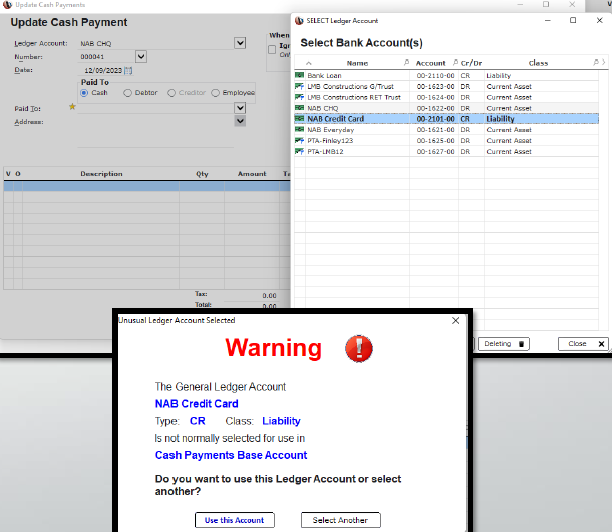
Single Transaction Details
Add the details of the charge, including the description, amount and expense ledger account.
If necessary multiple lines can be added. Job costing can also be added as required.
Once information is complete, click save to finalise the transaction.
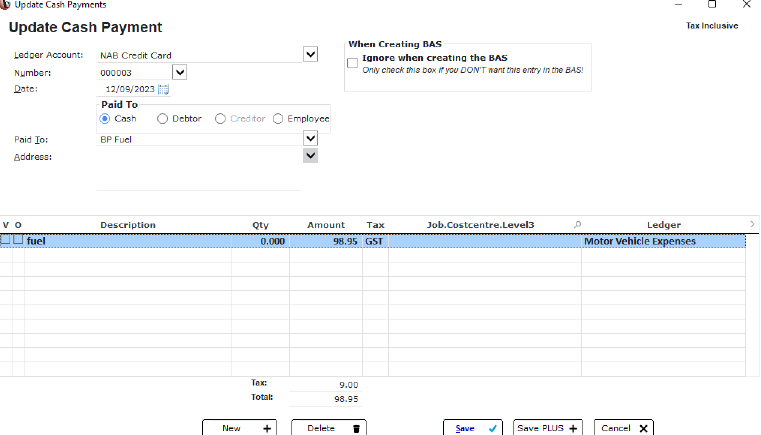
Making Payment
Enter the details of the transaction, selecting the bank account that the payment will come from.
Add the description of the transfer.
Leave the tax column blank as there is no GST on these types of transactions.
The last ledger will be the ledger for the credit card. This will attribute the payment for reconciliation purposes.
At the prompt click use this account and save the transaction.
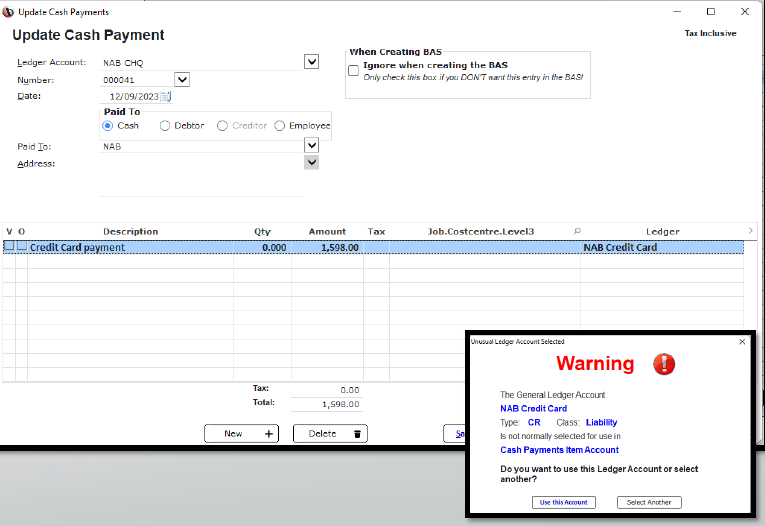
General Ledger Setting up Trust Accounts
Trust Bank Account
Bizprac’s general ledger allows for the use and management of Trust Accounts. Trust accounts are used in some states for the managing of payments to sub-contractors as well as managing Retention amounts.
QLD has specific guidelines and criteria for the management of these types of accounts, please refer to the relevant guide if you are in QLD.
Trust accounts can be setup in the same way as normal bank accounts. It should be noted that any payments made from a Trust account cannot be deleted. Depending on the circumstance a journal entry may be required.
Direct payments (ABA files) can be created for the Trust accounts & uploaded to the relevant banking software.
Setting Up the Account
Add the details of the Trust account being setup as you would for a bank account.
Add the name and select the class of the ledger.
Ticking the bank account option.
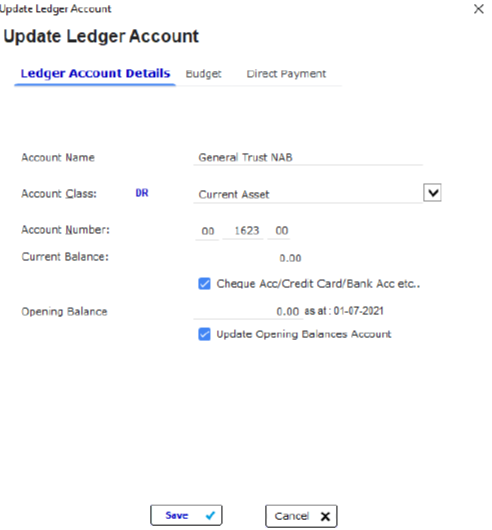
Direct Payment Tabs
Details of the bank and address may be added if required.
Add the details for the processing of the ABA file; your bank will provide you with these details.
Tick create a “self-balancing record”
Separate file paths for each account can be set. Clicking on select aba file path will allow you to set the desired location for this account.

Trust Accounts
Tick this is a Trust Account; you will receive a warning.
Entries processed through the Trust ledger cannot be changed.
Click create Trust Account, you will receive 2 warnings about creating a Trust ledger.
Print payee details will include the subcontractor’s nominated bank account details on the remittance.

Ledger View
The Trust accounts will be seen in the list and are denoted by a separate icon.
The blue drill down arrows allow you to drill into the ledger to view the associated transactions.
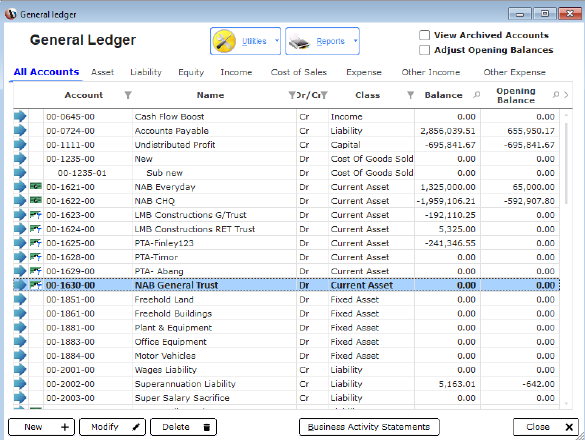
Things to Remember
Payments made from a Trust account can only be cancelled. Payments or transactions attributed to the trust ledger cannot be changed or deleted.
➢ All payments made for the trust account must be collated together for payment.
➢ Trust accounts CANNOT be changed or deleted.
General Ledger Setting up Loan & Credit Cards
Liability Accounts
Loan accounts and credit cards are setup in the ledger as liabilities to the company.
Loans could be an overdraft facility, car loan or credit card. As liabilities the ledger will go up or down as the transactions are processed. When adding ledgers for loan accounts an opening balance can be added to as to track the outstanding amount on the loan.
Credit Card
Add the details of the credit card, selecting the class as liability.
An opening balance can be added if required.
Click save when all details have been added.
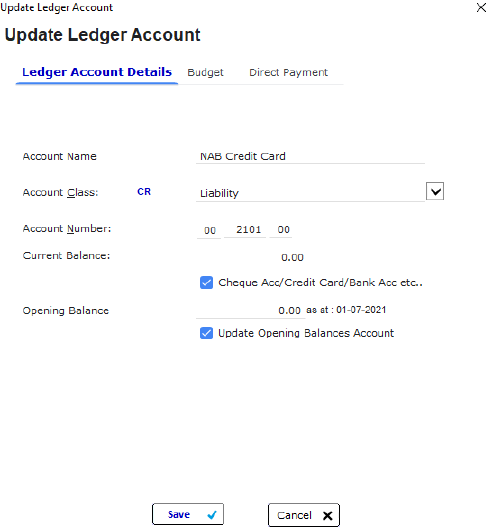
Loan Ledger
Add the details of the loan, selecting the liability class for the account.
Tick that the ledger is a bank account.
If required add an opening balance; remembering to check the date range.
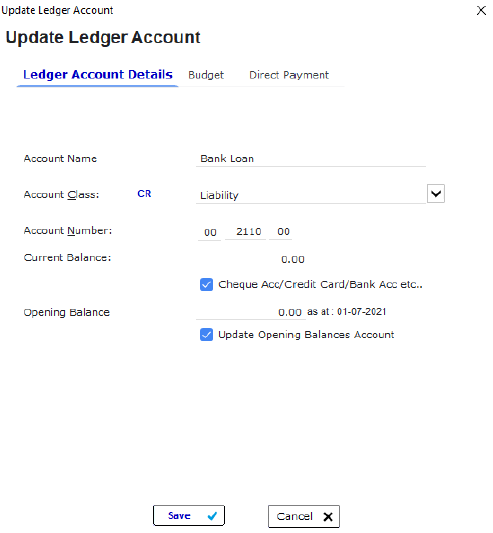
General Ledger Business Activity Statement (BAS)
BAS Explained
The Business Activity Statement is submitted to the ATO by all businesses to report their tax
obligations.
Depending on your business they may include:
➢ Reporting of GST
➢ Pay as you go withholding
➢ PAYG (employees)
➢ FBT
➢ Fuel rebates
➢ Any other tax applicable to your industry
Business activity statements are usually required quarterly but you may be obligated to report more
frequently.
Please note: Bizprac staff are not qualified tax agents. Anny queries about lodgement or your tax
obligations should be directed to your Accountant or the ATO.
Cash or Accrual
The BAS will calculate based on the settings selected for the Bookset. It will either be on a Cash or Accrual basis as determined by the ATO; if you are unsure on what basis you should be reporting you should contact either your accountant or the ATO.
Cash reporting: the transactions will calculate the GST on the basis of payments made and monies receipted.
Accrual reporting: calculation of the GST will be on the basis of the entry of the invoices either debtor or creditor, into the system.
Your BAS settings can be checked under the Setup tab. If directed to do so by the ATO the settings can be adjusted; please refer to the relevant guide.
Creating A New BAS
Insert a new BAS by clicking on the New button. The ABN will automatically be drawn from the business details contained in the Bookset.
Select the period to report and enter the start date, the end date will show automatically for the period selected.
If the PAYG is paid on a monthly basis use the override settings for the selected month.
Instalment Income override settings, add the required dates if necessary.
Once the relevant dates have been selected click save.
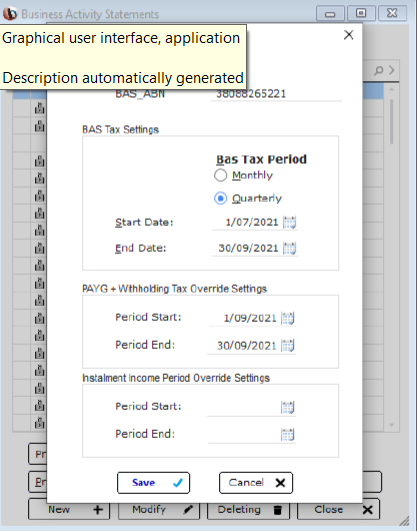
Installment Override Settings
PAYG instalments may be used to pay toward your expected end of year income tax liability.
The ATO will notify you if this is applicable to your situation.
If you receive this notification you will need to add the required dates. The details for this calculation will need to be added on the calculation sheet under the ‘T’ area.
Otherwise leave these dates blank.
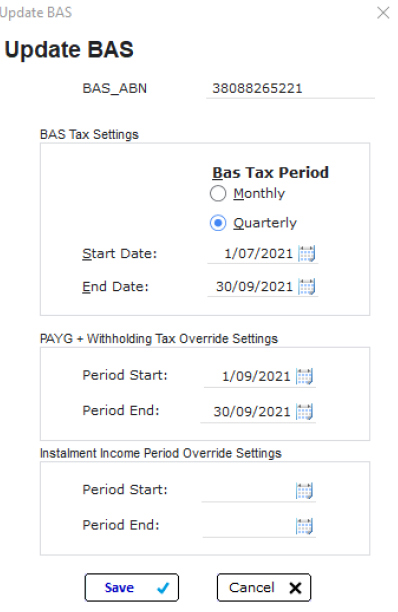
Start
To access the BAS calculation click on BAS details. From this screen you can also print the BAS form, print an audit trail and also create a receipt or payment for the BAS.
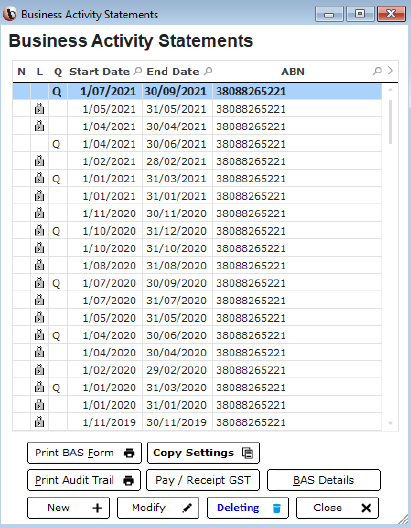
Activity Statement
The Business Activity Statement will show the amounts that will be needed to lodge the BAS.
Use the calculate button to prepare your BAS.
Check over the BAS audit trail and make any necessary adjustments.
Once the BAS is complete it can be locked to prevent any changes.
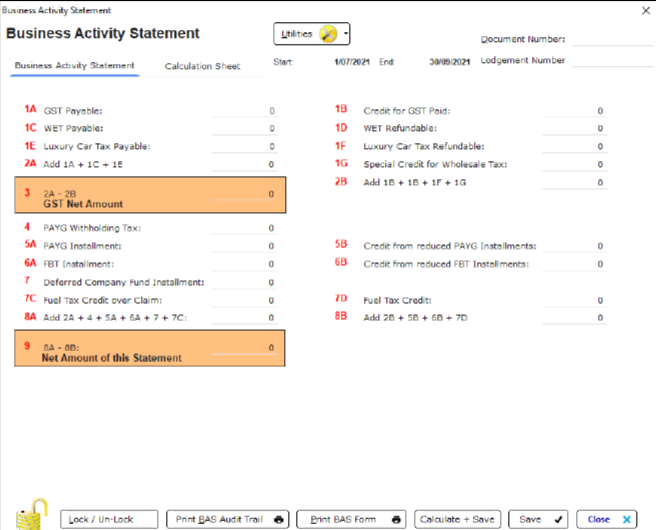
Calculation Sheet
The calculation sheet will show the relevant fields used for the calculation.
Each line has a radio button that contains the default GST codes used. Additional codes can be added if required by clicking on the radio button and selecting the relevant code.
All of these fields are pre-set in accord with ATO guidelines.
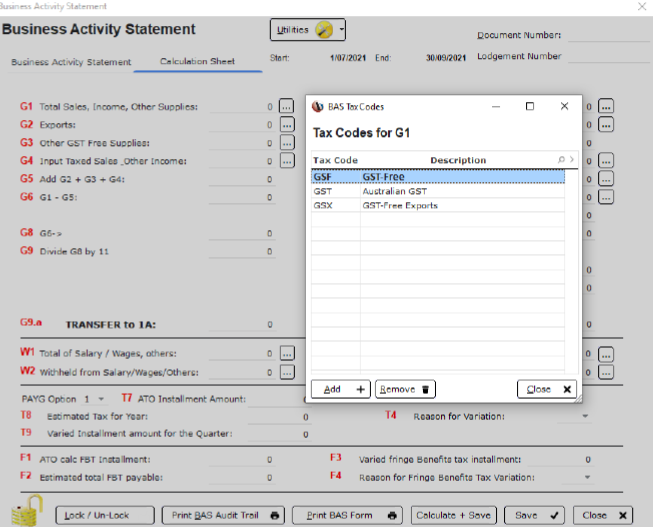
Wage & PAYG
To allow for calculation of wages and PAYG, the relevant ledgers will need to be added.
Click on the radio button for each of the W sections and add the relevant ledgers. If more than one wage ledger is used; all of the relevant ledgers will need to be selected.
Repeat the process for the W2 to calculate the PAYG.
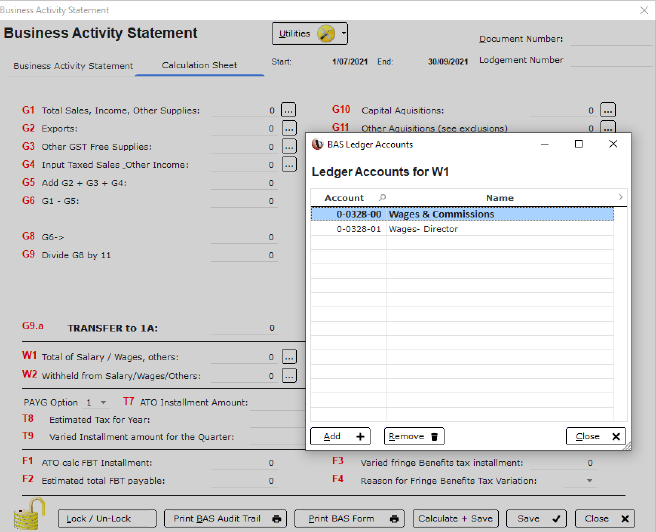
W3 & W4
W3 covers with-holding obligations that are not covered in W 1 & 2. Refer to ATO website for details; if you have nothing to report leave it blank.
W4 is used for with-holding obligations for subbies or if the subbie has not supplied a valid ABN. With-holding forms are found in the Creditor’s reports menu.
Use the radio buttons to add the relevant ledgers.

Let's Calculate
Using the calculate button, the BAS will automatically calculate and save the results.
The Audit trail will show where all of the transactions are sitting in the BAS and the areas they have been calculated from. By checking the audit trail prior to lodgement any necessary adjustments can be made.
Once the checks have been completed and nay necessary adjustments made; the BAS form can be printed and the BAS locked.
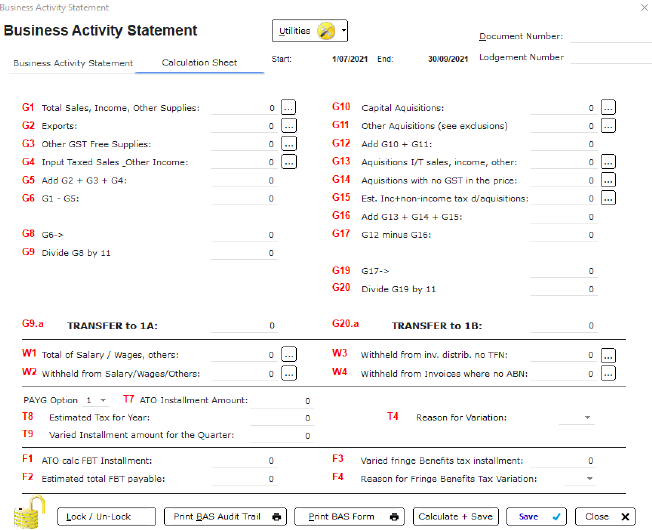
The 'T' Section - Option 1
The ‘T’ section found on the calculation sheet will only be used if directed to do so by the ATO. Option 1 populates the T7 box; this will be an amount set out by the ATO.
Click into T7 and add the amount designated; this amount will be included in the Net amount to be paid.
T8 & T9 will be used to vary the amount if required. Use the drop down box on T4 to select the relevant reason for the variance. Please refer to the ATO website for the variance references.

T- Option 2
T1 will be used to calculate the instalment income; using the radio buttons add all of the relevant income accounts from the General Ledger. The rate supplied by the ATO will be entered into the T2.
OR
If the rate is being varied; add the relevant figures as provided into T3. Select the variance reason from the drop down in T4.
Again once complete all of the calculations will be updated on the front screen.

FBT
Fringe Benefits Tax (FBT) is paid by employers on certain benefits they provide their employees.
There is extensive information on FBT obligations on the ATO website. Your accountant will also be able to advise on FBT obligations.
If you are unsure if you have an FBT obligation please consult your accountant or the ATO.

Fuel Credits and Other Adjustments
The ATO provides a Fuel Tax calculator to work out any fuel tax credits that may be applicable.
On the front of the BAS statement any adjustments for prior BAS or claims for Fuel Credits will be entered here.
Once the fuel credit has been calculated the figure will be entered into 7D. Any over claims will be entered into 7C.
Adjustments can be added into 5B & 6B as required.
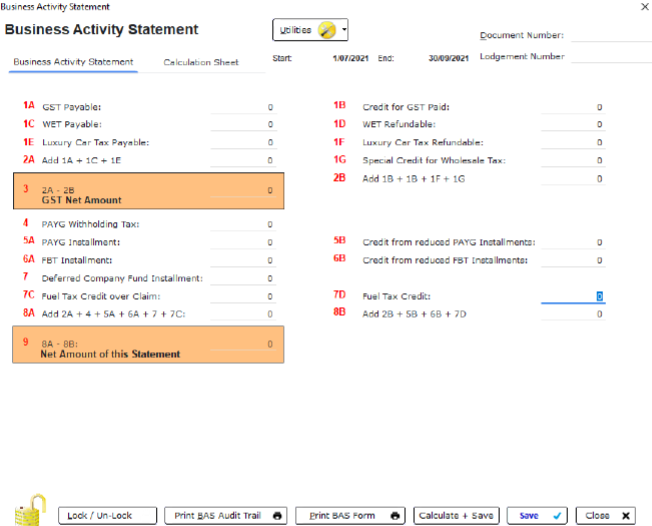
Copy BAS
To create a BAS for the next period, click on new and enter the dates for the next period.
Click OK and you will be asked if you would like to copy the previous settings. Clicking yes will copy all of the setting you have used in the previous BAS.
By clicking NO, the program will restore to the default settings for the BAS. Any required ledgers for the W, T sections will need to be re-selected.
Alternately click the copy settings and add the required dates. Process the BAS as normal.

Pay/Receipt GST
Once the BAS is complete and lodged; the payment or refund can be processed by clicking on the Pay/receipt button.
This will automatically setup the transaction and allocate to the relevant ledgers. If no additional information is required click on create transaction. The relevant transaction will then be completed.
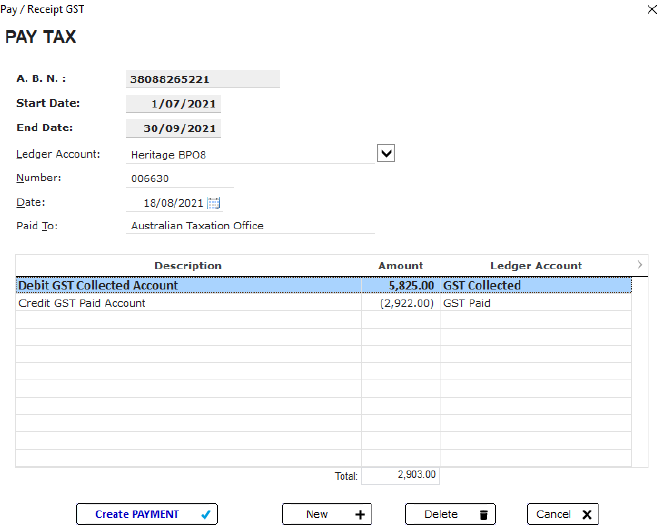
Default Ledgers
Default ledgers can be set for fuel rebates, FBT etc.
This area is found under the settings menu; pre-setting these fields will automatically populate when creating a receipt or refund.
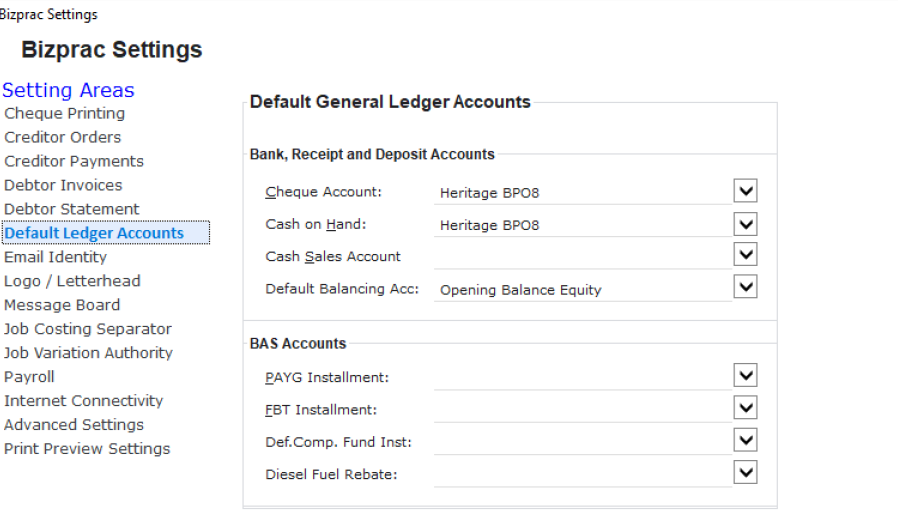
Did You Know?
Document and Lodgement numbers can be added to the BAS for later reference.
In the cash payments and cash receipts windows you can check to have a transaction ignored when creating the BAS.
This function would be used for transactions like ATO payments. Transactions excluded from the calculation will be listed in the audit trail under “entries with NO tax code”

Trouble Shooting
Use the BAS audit trail to check where the transactions are sitting. Any adjustments can be made prior to lodging the BAS.
The following are common issues that can occur:
“The transaction is not showing in the BAS”
➢ Have you calculated the BAS?
➢ Can you locate the transaction?
➢ Is the transaction in the date range for the BAS calculation?
➢ Does the transaction have the correct GST code?
“A transaction is showing in the BAS & it shouldn’t be”
➢ Does the transaction have the correct GST code attached?
➢ Has the transaction been ticked “do not include in BAS calculation” ?
NOTE: creditor payments in the cash payments list cannot be ticked to exclude from the BAS calculation.
“Wages are not showing or are not the correct amount”
➢ Check that the wages ledger is attached to the W1
➢ If you have multiple wage ledgers, have they all been added?
➢ Are the wages within the date range for the BAS period?
➢ Is there salary sacrifice that has not been processed correctly?
“The PAYG is higher or lower than it should be”
➢ If you pay PAYG monthly, ensure all of the dates are correct
➢ If you have made a payment to the ATO, ensure that the transaction is excluded from the BAS calculation
If you felt things don’t look “quite right” check the BAS by creating a NEW entry for the same period; click no & restore to default settings. Go through & add the relevant codes, calculate and compare.
Creditor payments can not be exclude from the BAS calculation; we do not recommend entering the ATO as a creditor and making payments through creditor invoice entries.
General Ledger Opening Balance
The opening balances will be the amount for the beginning of a new financial period; and will begin 1st July for the date range the database starts at. Bizprac will automatically create the opening balances upon the closing off of a financial period; when an end of year reset is completed.
When changing software the opening balances will need to be added for the beginning of the date range period.
Opening balances will always be from an as at date; adding opening balances can be as easy as modify the ledger and adding a balance. Bizprac’s Premium & Ultimate versions both have an add opening balances function; which will allow you to see the balances as you enter the figures.
The opening balances will be made up of the assets and liabilities in the listing. It is advisable to ensure you have all of the required ledgers entered prior to adding the balances.
In The Ledger
Highlight the ledger you wish to add the opening balance to and click modify.
Add the details of the opening balance; remembering that the opening balance is for the date as shown.

The Tick Box
By unticking the box, the ledger will update only the entry being adjusted. This could result in an imbalance in the ledger.
If the box is ticked the ledger will be updated and the balancing record will be updated automatically. The “opening balance equity” ledger is used in this situation.

Adjust Opening Balances
Bizprac’s Premium and Ultimate versions have an “Adjust opening balances option.
Tick the box to activate the screen.

Adding the Balances
Click into the column and begin adding the balances for each ledger as required.
If there is no amount the ledger will be left at 0.00.
As you enter the figures the ledgers will show if they are balanced; if they are unbalanced they will show by how much.

Balanced Ledger
As the figures are added through the accounts the columns will balance. If the amounts are out of balance they will show which side of the ledger needs adjusting.
Once the figures have been entered and the ledgers balanced click close.
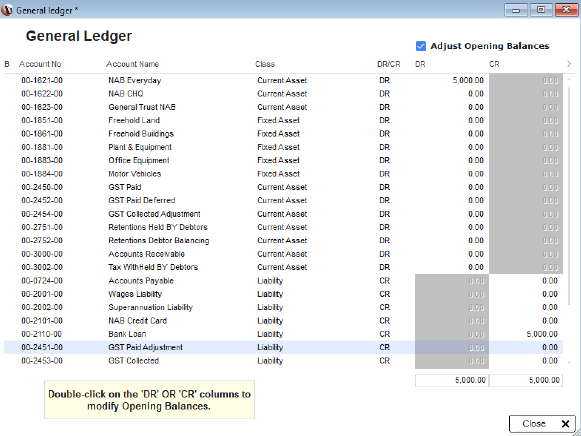
General Journals
The General Journal disperses bulks amounts to relevant ledgers, as in the case of payroll.
It can also be used to move funds between ledgers, redistributing funds.
A journal must always be balanced with a debit and a corresponding credit for each line.

Adding a Journal
When adding a Journal, the number will automatically added, add the date and a description of the entry. You will need a minimum of 2 lines with each line balancing. An unbalanced entry cannot be finalised.
Generally journal entries are included in the BAS calculation; for example journal entries are used in the BAS for W1 & W2 calculations. If you wish to exclude an entry from the BAS you may do so by ticking the box option.
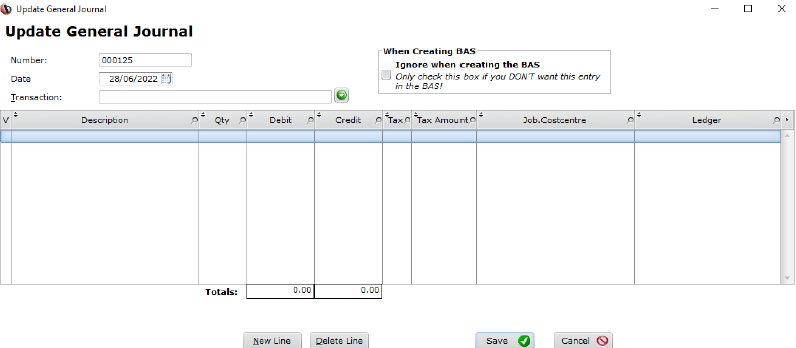
Journal Example
Example of a payroll journal.
Each of the entries has a corresponding debit & credit to the relevant ledgers.

Accounting Dashboard
The accounting dashboard available in Bizprac Premium & Ultimate versions gives you an instant overview of your business.
At a glance see movement between accounts, outstanding invoices for both debtors & creditors.


Ledger Account Movement
By selecting a ledger account you will be able to see the movement of the ledger over a period of months.
Re-select ledgers to view different areas of the business.
The view at the top will show which ledger has been selected.

View Options
View revenue/expenses or assets/liabilities at a glance.
You will be able to see the high and low movement as a graph.


Accounts Receivable
Provides you at a glance outstanding amounts.
The print option will allow you to report the invoices outstanding for each category listed.

Accounts Payable
Provides you at a glance outstanding amounts.
The print option will allow you to report the invoices outstanding for each category listed.










